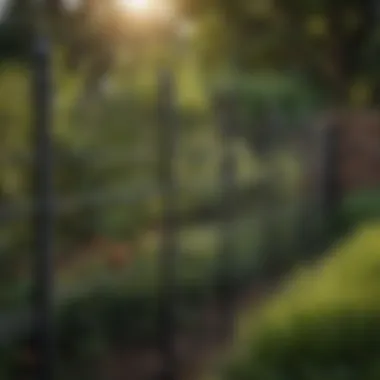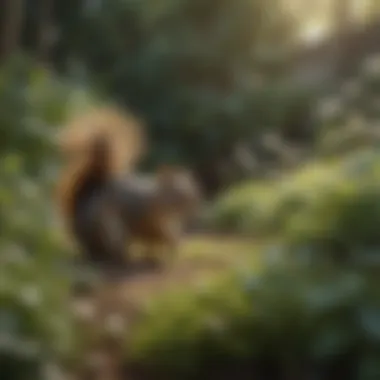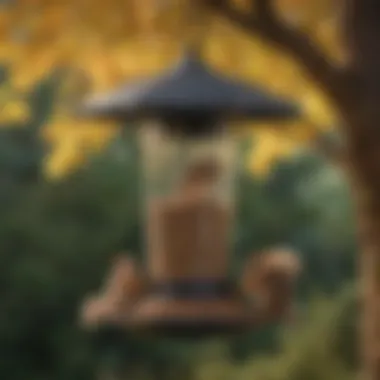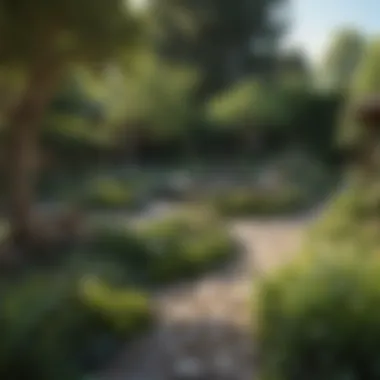Effective Strategies for Squirrel Deterrence


Intro
Squirrels can be charming creatures, but they can also wreak havoc in gardens. Their behavior includes foraging for food and digging up plants, which can lead to significant damage in a well-tended garden. It is crucial to understand various effective strategies to deter these animals. Protecting your garden does not need to come at the cost of harming the squirrels. This article will explore practical solutions that can help ensure your garden remains intact while respecting the wildlife around it.
Understanding Squirrel Behavior
To effectively deter squirrels, it is essential to understand their habits and behaviors. Squirrels are naturally curious and will explore their surroundings in search of food. Seasonal changes affect their activity levels, as they tend to gather more food in the fall in preparation for winter.
Food Sources
Squirrels are primarily attracted to gardens for their rich food supply. Common items that draw their attention include:
- Nuts, such as acorns and walnuts
- Fruits and vegetables, including berries and tomatoes
- Bird feeders, which can be a goldmine for squirrels
By identifying these attractants, homeowners can implement strategies to minimize their presence.
Physical Barriers
Creating physical barriers is one of the most effective methods of keeping squirrels out of your garden. Some practical solutions include:
- Fencing: A sturdy fence that is at least four feet high can deter squirrels. The fence should have a buried section to prevent digging.
- Netting: Using netting can protect individual plants or smaller areas of the garden. Be sure to secure the edges well.
- Raised Beds: Elevating garden beds can help deter access. Squirrels are less likely to jump into a raised bed, especially if it’s more than two feet high.
These measures can significantly reduce squirrel activity in your garden.
Natural Repellents
There are various natural substances that can repel squirrels without harming them. These are worth considering to complement physical barriers:
- Spices: Sprinkling cayenne pepper, chili powder, or garlic powder around plants can deter squirrels, as they dislike strong scents.
- Essential Oils: Oils like peppermint or citrus can be effective. Dilute the oil with water and spray it around the garden.
- Predator Urine: Some commercial products use predator urine to create a scent that squirrels instinctively avoid.
Squirrel-Proof Feeding Stations
For those who enjoy watching wildlife, consider installing squirrel-proof bird feeders. These feeders are designed to allow birds access while preventing squirrels from reaching the seeds. They can add a fun element to your garden without attracting squirrels.
Synthesis of Information
In overview, having a garden that thrives without interference from squirrels is entirely achievable with the right strategies. By understanding their behavior and utilizing physical barriers alongside natural repellents, you can create an environment that is less inviting to these creatures.
Important Note: Despite your best efforts, some squirrels may find a way into your garden. It is essential to remain consistent with your strategies and adjust them as necessary over time.
Implementing these strategies will allow you to protect your garden while still fostering a respect for nature. Finding a balance is key to creating a harmonious outdoor space.
Understanding Squirrels and Their Behavior
Understanding squirrels and their behavior is crucial for any garden owner facing challenges with these animals. This section presents insights into how squirrels interact with their environment, which helps to identify effective deterrence strategies. Knowing the specifics of squirrel behavior enables gardeners to implement targeted measures that influence squirrel activity and mitigate potential damage to plants and crops.
In addition, an awareness of the squirrels’ role in the ecosystem provides a broader perspective. Rather than viewing them solely as pests, understanding their natural behaviors can foster a balanced approach to cohabitating with wildlife. This emphasis helps to promote healthier gardens and minimize the negative impacts that squirrels might have.
The Role of Squirrels in the Ecosystem
Squirrels serve important functions in their ecosystem. They act as seed dispersers by gathering and storing nuts and seeds. This behavior unintentionally contributes to the growth of many plant species, which is beneficial for the environment. Moreover, squirrels are a food source for various predators, such as hawks and foxes. This interdependence plays a significant role in maintaining ecological balance.
Common Types of Squirrels
Tree squirrels
Tree squirrels typically inhabit forests and urban areas with plenty of trees. They are agile and excellent climbers, which allows them to access food sources high off the ground. Their diet consists mainly of nuts, seeds, and fruits. Understanding tree squirrels is essential for gardeners because they often raid bird feeders and damage young plants. Their tendency to hoard food can lead to unintentional garden harm.
A key characteristic of tree squirrels is their bushy tails, which aid in balance and communication. However, while they contribute positively to ecological dynamics, their resourcefulness can pose challenges for garden maintenance.
Ground squirrels


Ground squirrels dwell in burrows, which they excavate in grassy areas. These squirrels are known for their sociable nature, often living in colonies. They primarily consume seeds, nuts, and green vegetation, making them relevant to garden contexts. Their appetite for vegetable crops can result in considerable damage within gardens.
One distinct feature of ground squirrels is their behavior of foraging in groups, which can amplify garden destruction if not managed. Their sociability makes them a concern for gardeners who strive for a fruitful harvest.
Flying squirrels
Flying squirrels, unlike their tree and ground counterparts, have a notable ability to glide through the air. This adaptation enables them to access food sources from the tops of trees. They also consume a diet rich in fruits and nuts, and their gliding skill offers them a significant advantage in foraging.
However, their nocturnal habits mean they may not always be visible during the day. This aspect can mislead gardeners into neglecting their presence. While they are less common nuisances compared to tree and ground squirrels, understanding their behavior is still beneficial for comprehensive garden management.
Squirrel Behavior and Feeding Habits
Squirrels are primarily diurnal, meaning they are active during the day. Their behavior includes foraging, nesting, and social interactions. Most notably, feeding habits vary by species, with diets gravitating toward seasonal availability. Often, they will cache food for later consumption.
By observing feeding patterns, gardeners can adjust their deterrent methods, choosing strategies effective during specific times of the year. Understanding the feeding habits also assists in determining which plants could be vulnerable to damage from these animals.
In summary, comprehending squirrel behavior and types serves as a foundation for developing effective strategies to reduce their impact on gardens. As this article progresses, identifying methods of deterrence will become a focal point that builds on this initial understanding.
Assessing the Impact of Squirrels on Gardens
Understanding the impact of squirrels on gardens is essential for maintaining a healthy and thriving outdoor space. Squirrels are known for their lively behavior and playful antics, but they can also cause significant damage to plants, seeds, and structures. Homeowners must recognize the potential challenges that squirrels present in their gardens and develop strategies to mitigate these problems. This section will explore common types of damage caused by squirrels, as well as how to identify their activities, aiding gardeners in taking the necessary actions for prevention.
Common Damage Caused by Squirrels
Seed and Bulb Extraction
Seed and bulb extraction represents one of the most common forms of damage squirrels inflict on gardens. Squirrels have a natural instinct to forage and cache food for later use. This behavior often leads them to dig up freshly planted seeds and bulbs rather than seeking out alternatives. The characteristic of this damage is straightforward - squirrels will uproot seeds and bulbs from the ground, leaving a visibly disturbed patch where they were planted. This is a pivotal issue for any gardener aiming to establish a flourishing garden.
The primary reason this type of damage is considered highly detrimental is that it directly affects the gardener's investment in time and resources. Losing seeds and bulbs can lead to poor plant growth or even crop failure. Additionally, this behavior can cause frustration and disappointment for those who invest effort into their garden.
Damage to Plants and Crops
The damage squirrels do to plants and crops goes beyond just seeds; they also tend to chew on the tender parts of plants, such as leaves and stems. As they seek nutrients or food sources, they may accidentally or purposely strip away foliage, damaging the plant's ability to photosynthesize properly. This type of feeding behavior can significantly weaken the plants, reducing yields and sometimes killing them altogether.
This damage is particularly alarming for vegetable gardeners, who invest time cultivating crops meant for harvest. Damage to plants not only translates to economic loss but can also alter the aesthetics of a garden, impacting the overall enjoyment of the space. Consequently, addressing this issue is paramount for gardeners aiming for successful growth.
Chewing on Garden Structures
Squirrels are also known to chew on garden structures, which includes trellises, fences, and even garden furniture. This characteristic behavior may stem from their need to file down their sharp teeth or to create nesting materials. The chewing can cause unsightly damage to structures that homeowners value or rely on for functionality in their garden setup.
The implications of this damage reach beyond mere aesthetics. Repairs may incur expenses, and in some cases, it could compromise the integrity of supporting structures. This means gardeners must be vigilant and proactive in managing the presence of squirrels to prevent further destruction.
Identifying Evidence of Squirrel Activity
To effectively dissuade squirrels from causing damage, it is vital to identify their activity within your garden. There are several signs that can indicate squirrel presence:
- Tracks and Chewing Marks: Look for small paw prints or chew marks on branches and furniture.
- Nesting Sites: Squirrels often build nests in trees or shrubs; signs include shredded bark or nearby debris.
- Food Storage: Squirrels may leave behind nuts or seeds that they have buried or hidden.
By recognizing these signs, gardeners can better understand squirrel behavior and subsequently develop tailored deterrent strategies. Monitoring these elements will help maintain the integrity of your garden space, ensuring rich blooms, and healthy yields.
Popular Squirrel Deterrents
Squirrel deterrents play a crucial role in protecting gardens from unwelcome visitors. Understanding the various options available helps homeowners maintain their outdoor spaces effectively. This section discusses three major categories of deterrents: physical barriers, natural repellents, and commercial products. Each category comes with its specific elements and benefits that contribute to a comprehensive approach to squirrel management.
Physical Barriers
Fencing strategies
Fencing is an effective way to physically limit squirrel access to your garden. Utilizing the right material is critical for optimal results. A good fence should be tall enough to deter climbing, generally around four to six feet in height. Beyond height, an important characteristic is the material used. Wire mesh is commonly chosen due to its durability and effectiveness.
Key characteristics of fencing strategies include:


- Height: A taller fence is more effective in keeping squirrels out.
- Material: Wire mesh or chicken wire can prevent entry while allowing light and air through.
However, one should note some unique features of fencing. While it may successfully deter many squirrels, it can be expensive to install and require maintenance over time.
Netting and mesh covers
Netting and mesh covers offer another layer of protection for gardens. They can shield plants from squirrels while still allowing sunshine and rain to nourish them. This method serves as a physical barrier without obstructing normal growth conditions.
Key characteristics of netting include:
- Flexibility: Netting can be adapted to cover a variety of shapes and sizes of plants.
- Lightweight: Easy to handle and install, making it a popular choice.
However, unique features such as susceptibility to tears and wear over time should be considered. These barriers can be less durable compared to rigid fencing but are often easier to deploy and remove.
Natural Repellents
Spicy pepper sprays
Spicy pepper sprays serve as an effective natural deterrent due to their strong scent and taste. Formulations based on capsaicin disrupt the feeding patterns of squirrels, prompting them to seek food elsewhere. This also signifies a non-toxic approach, making it a favored choice among environmentally-conscious gardeners.
Key characteristics include:
- Effectiveness: Proven to repel squirrels due to their sensitivity to spicy compounds.
- Safety: Non-toxic for plants and pets as long as used responsibly.
Unique features of spicy pepper sprays are mainly their renewable nature, as they need to be reapplied after rain or watering, which can become an ongoing task for the gardener.
Citrus-based deterrents
Citrus-based deterrents, derived from oranges, lemons, or grapefruits, can also be effective against squirrels. The strong, unpleasant smell discourages them from approaching. Like spicy pepper sprays, these are non-toxic and can be made at home easily.
Key characteristics include:
- Pleasant aroma for humans: Unlike some other repellents, these offer a pleasant scent.
- Home-made options: Easy to create sprays using citrus peels and water.
However, the unique features of citrus sprays include a limited duration of effectiveness. Gardeners must frequently reapply the spray to maintain protection against squirrels.
Commercial Squirrel Deterrents
Ultrasonic devices
Ultrasonic devices can be a high-tech solution to squirrel problems. These devices emit high-frequency sounds that are inaudible to human ears but disruptive to squirrels. They can cover a larger area compared to most ground-level deterrents.
Key characteristics include:
- Coverage area: Ultrasonic devices often provide broader coverage than localized methods.
- Ease of use: Simply plug in and activate, requiring no physical labor.
However, the unique features come with limitations, such as the potential ineffectiveness against all squirrels and reliance on electricity.
Chemical repellents
Chemical repellents are widely available and designed for specific use against squirrels. Many contain strong scents that disrupt the feeding behavior of these rodents. They are generally easy to apply but should be used with caution, particularly around pets and children.
Key characteristics include:
- Wide variety: Options available for every gardener's need and comfort level.
- Immediate results: Often provide quick deterrence after application.
However, unique features encompass potential health risks because of toxic chemicals. Regular monitoring and reapplication are also necessary, which can increase overall costs.
Integrating Deterrents into Your Garden Plan
Integrating deterrents into your garden plan is essential for achieving an effective balance between garden aesthetics and functionality. By strategically incorporating these deterrents, homeowners can create an environment that minimizes squirrel activity while still allowing for a vibrant and productive garden. This section discusses various design considerations and seasonal adjustments to help you navigate this task more effectively.


Design Considerations
Plant choice and placement
Choosing the right plants and their placement in the garden can significantly influence squirrel behavior. Certain plants may attract squirrels due to their edible parts, while others tend to repel them. For instance, incorporating plants like marigolds and garlic can deter these rodents due to their strong odors. The key characteristic here is the ability of some plants to act as natural deterrents or attractants.
When planning your garden, consider grouping plants that are less likely to attract squirrels together. This is a beneficial approach as it creates areas that are less appealing to these animals. Additionally, placing plants high enough from the ground can reduce accessibility.
However, there can be disadvantages to specific plant choices, as some might require more attention or care. Understanding these aspects can lead to a more harmonious garden environment.
Creating a discouraging environment
Establishing a discouraging environment is crucial for effective squirrel deterrence. This involves manipulating the garden layout and using certain environmental features to make the area less appealing to squirrels. For example, keeping garden areas tidy by removing fallen fruits and nuts reduces food availability. The key characteristic of this strategy lies in maintaining cleanliness and order.
A unique feature of creating a discouraging environment is the implementation of noise or movement deterrents, such as wind chimes or motion-activated devices. These can disrupt the squirrels' comfort zone, making them less likely to visit. These methods are typically advantageous because they are low-maintenance and eco-friendly.
Seasonal Adjustments
Spring strategies
In spring, it is important to adopt specific strategies to deter squirrels as they emerge from their winter dormancy. A significant aspect of spring strategies involves early planting and covering tender seedlings with protective materials. Using row covers or netting can shield young plants from squirrel interference.
The key characteristic of this approach is proactive protection. Installing physical barriers from the start of spring can significantly improve the chances of plants surviving.
However, while these measures can be highly beneficial, they may also delay plants’ growth if not managed properly. Monitoring the young plants closely is crucial for achieving the best outcomes.
Winter preparations
Preparing your garden for winter is equally essential. During this time, prevent squirrels from seeking food in your garden by removing any remaining edible plants and debris. This aspect of winter preparations helps deter squirrels, making them less likely to return for food. The key characteristic of this approach is resource management.
A unique feature of winter preparations is insulating your garden space. Using mulch can protect plants and apply a layer of deterrent against squirrel digging. This strategy is advantageous because it benefits the plants while also acting as a barrier. Failure to prepare the garden can lead to increased squirrel activity, which could jeopardize your gardening efforts.
"An effective squirrel deterrent plan requires constant monitoring and adjustment to align with the garden's changing seasons."
By integrating deterrents into your garden plan through thoughtful design considerations and seasonal adjustments, you will create a more resilient and squirrel-resistant garden.
Long-term Management of Squirrel Populations
Managing squirrel populations in your garden requires a strategic approach focused on sustainability and effectiveness. Long-term management is essential for several reasons. First, it helps maintain a balance in your garden's ecosystem, minimizing potential damage by ensuring squirrels do not become habitual pests. Secondly, it fosters a more peaceful coexistence with wildlife, allowing squirrels to inhabit areas without infringing on your gardening efforts.
Monitoring and Adjusting Strategies
Continuous monitoring is crucial for effective squirrel management. Regularly observing squirrel activity can help identify patterns and problem areas. If you notice an uptick in squirrel presence or damage to your plants, it may be time to adjust your strategies. This involves:
- Keeping a log: Document the times and types of squirrel interactions in your garden. This can help inform future strategies.
- Assessing effectiveness: Evaluate which deterrents work best. Some may be more effective than others based on your garden layout and plant choices.
- Implementing changes: Don’t hesitate to switch up your methods. For instance, if a particular natural repellent is not effective, consider trying a different type or combining methods for a more robust approach.
Through these adjustments, you can tailor your management techniques to meet the specific needs of your garden environment, therefore enhancing its resilience to squirrel activity.
Community Recommendations and Support
Widening the discussion of squirrel management can lead to community-based solutions. Engaging with neighbors and local gardening groups can provide insights into effective strategies and shared experiences. Communities can benefit from recommendations such as:
- Sharing experiences: Discussing successful methods can lead to innovative deterrents that haven't been tried individually.
- Organizing workshops: Local gardening clubs may host workshops on effective outdoor management techniques, fostering a collective approach to squirrel deterrence.
- Advocating for local resources: Community gardening initiatives might have access to resources or grants that support environmental management.
Culmination
Squirrel deterrence is an essential aspect of maintaining the health and beauty of your garden. In this article, we have explored various methods to address the challenges posed by squirrels. Understanding their behavior, assessing their impact, and integrating effective deterrent strategies contribute to the overall success of gardening endeavors.
Summary of Effective Deterrent Strategies
The strategies discussed can be summarized into several effective categories:
- Physical Barriers: Utilizing fences and nets can keep squirrels at bay. For example, strong fencing can prevent access while netting can protect specific plants.
- Natural Repellents: Natural solutions like spicy pepper sprays or citrus-based products offer a humane method to deter squirrels without chemical substances.
- Commercial Deterrents: Ultrasonic devices and specialized chemical repellents can act as additional measures to discourage squirrel visits.
- Design Considerations: The choice and placement of plants, as well as creating an environment that is less attractive to squirrels, can significantly reduce their interference.
- Seasonal Adjustments: Adapting strategies according to the seasons ensures ongoing protection and maximizes the effectiveness of deterrents throughout the year.
Encouraging a Balanced Coexistence
While deterring squirrels is vital, it is equally important to consider a harmonious relationship with wildlife. Protecting your garden doesn’t mean eliminating squirrels completely. Educating yourself on their role in the ecosystem can foster respect for all creatures. Planting squirrel-friendly species, like sunflowers or other options, can offer them alternative food sources. This approach encourages a balanced relationship with nature, allowing both gardeners and squirrels to thrive in their respective spaces, leading to a garden that is both beautiful and ecologically sound.
Key takeaway: Implementing effective squirrel deterrents while fostering a coexistence strategy creates a sustainable gardening environment, enhancing both beauty and biodiversity.















